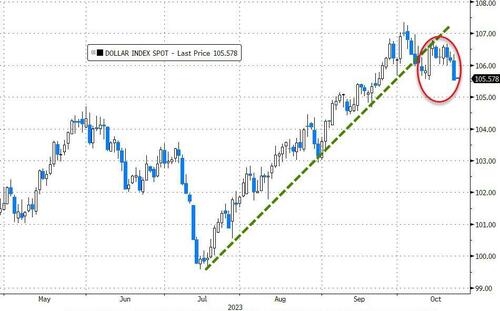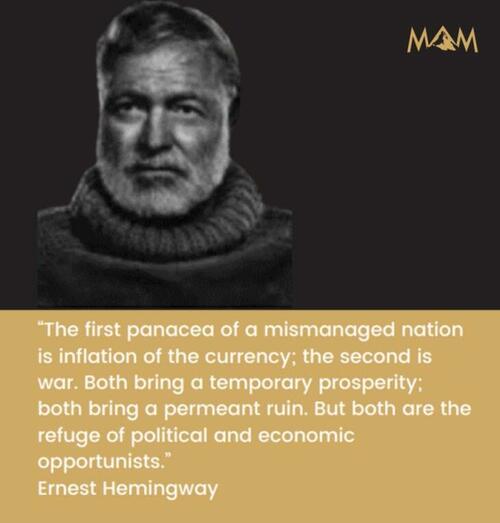
Authored by Matthew Piepenburg via GoldSwitzerland.com,
Below, we follow the breadcrumbs of simple math and bond market signals toward an oft-repeated pattern of how once-great nations become, well…not so great any more.
Debt Destroys Nations
Debt, once it passes the Rubicon from extreme to just plain madness, destroys nations.
Just ask the former Spanish, British or Dutch empires. Or ask the inter-war Germans. Ask the Yugoslavians of the 1990’s or ask a historian of Ancient Rome or a merchant in modern Argentina.
It’s all pretty much the same story, just different a different stage or curtain call.
Like Hemingway’s description of poverty, the process begins slowly at first, and then all at once.
Part of this process involves currency debasement needed to pay down more desperate issuance of IOUs, a process evidenced by rising rather than “transitory” inflation.
Thereafter, comes increased social unrest, and hence increased centralization from the political left or right in the name of “what’s best for us.”
Sound familiar?
Centralization—The Last, Failed Act
Centralization never works in the long run, but that has never stopped opportunists from trying.
Just look at our central bankers.
In a centralized rather than free market, the very name “central bank” should be a dead give-away as to their real role and profile.
As private central banks have been slowly increasing their hidden power and control over national markets and hence national welfare, the very notion of free price discovery in bonds, and indirectly in stocks, is now all but an extinct financial creature in the neo-feudalism which long ago replaced genuine capitalism.
How the Central Game is Played—From Temporary Prosperity to Permanent Ruin
When central banks like the Fed repress rates and print gobs and gobs of money, bonds are artificially supported, which means their prices go up and their yields are compressed.
When yields are low, rates are low, which means the cost of credit is cheap, allowing otherwise profitless names in the stock markets to borrow money and time for years of temporary prosperity—like a 600% rise in a post-08 S&P…
In short: central bank repressed rates are a profound tailwind for otherwise mediocre risk assets.
But when central banks like the Fed raise rates (ostensibly to “fight inflation”), the opposite effect happens—and things break. I mean really break.
I’ve written and spoken ad nauseum about what has broken, is breaking and will continue to break; furthermore, I’ve written and spoken at length about the quantifiable irony that Powell’s so-called war on inflation will only end in more inflation.
Yep, the ironies just abound in this world of so-called experts, which is little more than an island of misfit toys.
Postponing Pain Only Heightens It
In normal, free-market cycles devoid of central bank “support,” bonds and hence rates rise and fall naturally based on natural demand and natural supply.
Imagine that?
This leads to frequent but healthy moments of what von Mises and Schumpeter described as “constructive destruction”—i.e., a cleaning out of debt-soaked and crappy enterprises in naturally occurring recessions and naturally occurring market drawdowns.
But central banks somehow thought they could outlaw recessions by printing money out of thin air to support bonds and repress yields. You know—solve a debt crisis with more debt. Brilliant…
This was hubris at the highest level, and the stupid just became a habit and even received a fancy name to justify it—Modern Monetary Theory.
Natural Market Forces Are Stronger than Central (Bank) Forces
But the longer central banks postponed pain to win Noble Prizes and ego-lifting acclaim from the un-informed, the greater the natural pain (ticking time bomb) these central planners created as they now slowly realize that the bond market, like an ocean, is more powerful than a band of unelected market stewards.
In fact, a bunch of FOMC officials (Kashkari, Bostic, Waller et al.) are now running around like headless chickens and declaring that higher bond yields may now be more powerful than the Fed Funds Rate.
In other words, after months of hawkish chest-puffing, they are saying that perhaps enough is enough with the “higher for longer” meme…
Central bankers, it seems, are beginning to realize what informed credit market jocks have always known, viz: The bond market is stronger than any central bank.
Price Matters
That is, eventually central bankers lose control of artificial bond pricing.
Which means that eventually the great weight of sinking bonds and hence rising yields and rates becomes more powerful than central bank money printers to keep those bonds artificially “supported.”
I’ve been saying this for years despite “journalists” at the WSJ and Financial Times calling math-based realists like me “kooks.”
But recently even the fine folks at the WSJ or Financial Times (FT) are beginning to worry out loud as UST supplies far outstrip natural demand, causing bond prices to fall and yields and rates to rise fatally higher than central bankers once thought safely under their control.
We’ve warned of this for years—and this grotesque supply and demand mis-match has only risen exponentially in recent months.
America: Running Out of Takers/Suckers for Its Ever-Increasing IOUs?
The trillions in spending forecasted for year-end and into 2024 just don’t have any real money behind it, which means more IOUs will be spitting out of DC with less and less love/demand for the same.
This, of course, has been a real problem hiding in plain site for a long, long time.
As supply outpaces demand for sovereign bonds, their prices sink, their yields rise and hence interest rates—the cost of debt—becomes fatal rather than just painful.
The journalists at the FT, most of whom never sat at a trading desk, however, still have a very hard time imaging the unspeakable—i.e., a total implosion of sovereign bonds, and hence a total implosion of the financial system.
Thinking About the Unthinkable
They still see the UST as too big to fail—or to use their own words, any failure of this sacred US Sovereign bond is “unthinkable.”
Well…think again.
But at least the main-stream-financial pundits are crying that any real threat to Uncle Sam’s IOUs “would force the state to act.”
For once, I actually agree with these “journalists.”
But let’s clarify what “forcing the state to act” really means—i.e., in simple speak.
When There’s No Good Acts Left to Take
In short, this means the “state” would have to “act” by saving the bond market in particular and the global financial system in general via trillions and trillions of printed dollars to purchase otherwise unloved IOUs from Uncle Sam.
In other words, the only way to save bonds is to kill currencies.
This, by the way, is a now familiar trajectory to any one paying attention (think of the September 2019 repo crisis, the March 2020 Covid crash or the 2022 Gilt crisis in the UK) the implications of which we’ve been warning well ahead of the pundits.
Such “state action,” of course, slowly kills the USD—but as I’ve also warned for years, the last bubble to pop in every centralized, debt-soaked financial failure throughout history is always the currency.
The once exceptional USD, sadly, is no exception. It just takes longer, a lot longer, to bring down a world reserve currency.
This, by the way, is not “gold bug sensationalism” but simple history supported by simple math—two disciplines our leaders, financial journalists and even bankers either don’t grasp or do their best to ignore, cancel or dismiss.
Again, with the ironies.
Even the Media Can’t Deny the Obvious
But at least the main stream pundits are catching on. This is only because the problem of unprecedented deficits alongside rising bond yields and hence debt costs are now too obvious to ignore.
The WSJ recently wrote that “deficits finally matter.”
Hmmm. They have mattered for a long time—just saying…
Telegraphing a Weaker USD?
In the end, and as warned over and over and over (and as confirmed, it seems, even by the squawking Fed officials above), the facts and Fed-speak all point toward a talking down of the USD in favor of Uncle Sam’s broken IOU.
That is, the media is already planting the seeds for the USD’s painful endgame.
This comes as ZERO surprise, despite the Greenback’s relative status as the best horse in the global glue factory.
And, at least for now, that USD is breaking well off its prior uptrend…
This weaker USD will provide needed liquidity relief for an over-stretched UST market.
But the USD (and DXY) will have to come down much further, in my opinion, to buy sovereign bond markets needed time.
Pick Your Poison: Busted Financial System or Neutered USD?
Eventually a choice will have to be made between saving the system (of which sovereign bonds are the foundation) or sacrificing the currency.
In other words, get ready for more dollar-destroying “state action” from that non-state/private enterprise otherwise known as the Fed—all in the form of direct magical mouse-click money.
The Postponed Pivot Already Began
For over a year, this inevitable Fed pivot toward QE was delayed by back-door QE-like measures from Yellen’s Treasury Department (i.e., refilling the Treasury General Account with T-Bills) or the dual (and multi-trillion) accounting tricks of BTFP bank-bailout (by which Uncle Sam guaranteed par value return to the banks but market value losses to the suckers on Main Street…)
Or War Might Be in Order? Ask Hemingway
In fact, the only thing that could publicly justify (and partially absorb) another massive dose of 2020-like money printing (and hence currency debasement) would be a big, fat, ugly war with war-like “emergency measures” whereby our leaders can blame decades of debt-addiction on battle smoke (or COVID, Putin, and men from Mars) rather than their own bathroom mirrors.
Again, Hemingway was likely onto this trend long before the WSJ or FT:
Around and Round We Go
But with conflicts now red hot in both the Ukraine and Israel, Biden and his broken bond market are hitting an inflection point where the USA just can’t really afford more war support to its allies without thinning the USD and over-stretching its UST.
And so, folks… around and round we go in the ultimate vicious circle within which all debt-soaked nations throughout history ultimately find themselves.
That is: 1) poorly managed nations get too drunk on debt, and then 2) debase their currency to pay their debt; thereafter, 3) inflation comes, followed by 4) rising rates to fight that inflation, which in turn means 5) higher debt service costs, which means 6) more inflationary currency creation is rolled out to pay those higher rates.
Stated more simply, the USA has hit the Fiscal Dominance arc of the debt-cycle vicious circle wherein fighting inflation just creates more inflation.
The World Is Catching On…
We, of course, are not the only ones who see this.
In fact, pretty much the entire world is catching on, with the BRICS+ nations making the first steady moves (de-dollarization) as eastern and other central banks continue to stack physical gold at record-levels in preparation for the slow but steady decline (not death, nod to Brent Johnson) of the World Reserve Currency.
As I recently wrote, just like kings bring horses and canons to their borders to defend against an approaching invader, central banks are stacking physical gold to defend against a debased USD.
It’s just that obvious.
This may explain why gold continues to rise in London and NYC despite so-called “positive real rates” and a still relatively strong USD.
That is, the world, including the Shanghai gold exchange, is seeing the golden lighthouse through the smoke of burning currencies.
Are you?
Authored by Matthew Piepenburg via GoldSwitzerland.com,
Below, we follow the breadcrumbs of simple math and bond market signals toward an oft-repeated pattern of how once-great nations become, well…not so great any more.
Debt Destroys Nations
Debt, once it passes the Rubicon from extreme to just plain madness, destroys nations.
Just ask the former Spanish, British or Dutch empires. Or ask the inter-war Germans. Ask the Yugoslavians of the 1990’s or ask a historian of Ancient Rome or a merchant in modern Argentina.
It’s all pretty much the same story, just different a different stage or curtain call.
Like Hemingway’s description of poverty, the process begins slowly at first, and then all at once.
Part of this process involves currency debasement needed to pay down more desperate issuance of IOUs, a process evidenced by rising rather than “transitory” inflation.
Thereafter, comes increased social unrest, and hence increased centralization from the political left or right in the name of “what’s best for us.”
Sound familiar?
Centralization—The Last, Failed Act
Centralization never works in the long run, but that has never stopped opportunists from trying.
Just look at our central bankers.
In a centralized rather than free market, the very name “central bank” should be a dead give-away as to their real role and profile.
As private central banks have been slowly increasing their hidden power and control over national markets and hence national welfare, the very notion of free price discovery in bonds, and indirectly in stocks, is now all but an extinct financial creature in the neo-feudalism which long ago replaced genuine capitalism.
How the Central Game is Played—From Temporary Prosperity to Permanent Ruin
When central banks like the Fed repress rates and print gobs and gobs of money, bonds are artificially supported, which means their prices go up and their yields are compressed.
When yields are low, rates are low, which means the cost of credit is cheap, allowing otherwise profitless names in the stock markets to borrow money and time for years of temporary prosperity—like a 600% rise in a post-08 S&P…
In short: central bank repressed rates are a profound tailwind for otherwise mediocre risk assets.
But when central banks like the Fed raise rates (ostensibly to “fight inflation”), the opposite effect happens—and things break. I mean really break.
I’ve written and spoken ad nauseum about what has broken, is breaking and will continue to break; furthermore, I’ve written and spoken at length about the quantifiable irony that Powell’s so-called war on inflation will only end in more inflation.
Yep, the ironies just abound in this world of so-called experts, which is little more than an island of misfit toys.
Postponing Pain Only Heightens It
In normal, free-market cycles devoid of central bank “support,” bonds and hence rates rise and fall naturally based on natural demand and natural supply.
Imagine that?
This leads to frequent but healthy moments of what von Mises and Schumpeter described as “constructive destruction”—i.e., a cleaning out of debt-soaked and crappy enterprises in naturally occurring recessions and naturally occurring market drawdowns.
But central banks somehow thought they could outlaw recessions by printing money out of thin air to support bonds and repress yields. You know—solve a debt crisis with more debt. Brilliant…
This was hubris at the highest level, and the stupid just became a habit and even received a fancy name to justify it—Modern Monetary Theory.
Natural Market Forces Are Stronger than Central (Bank) Forces
But the longer central banks postponed pain to win Noble Prizes and ego-lifting acclaim from the un-informed, the greater the natural pain (ticking time bomb) these central planners created as they now slowly realize that the bond market, like an ocean, is more powerful than a band of unelected market stewards.
In fact, a bunch of FOMC officials (Kashkari, Bostic, Waller et al.) are now running around like headless chickens and declaring that higher bond yields may now be more powerful than the Fed Funds Rate.
In other words, after months of hawkish chest-puffing, they are saying that perhaps enough is enough with the “higher for longer” meme…
Central bankers, it seems, are beginning to realize what informed credit market jocks have always known, viz: The bond market is stronger than any central bank.
Price Matters
That is, eventually central bankers lose control of artificial bond pricing.
Which means that eventually the great weight of sinking bonds and hence rising yields and rates becomes more powerful than central bank money printers to keep those bonds artificially “supported.”
I’ve been saying this for years despite “journalists” at the WSJ and Financial Times calling math-based realists like me “kooks.”
But recently even the fine folks at the WSJ or Financial Times (FT) are beginning to worry out loud as UST supplies far outstrip natural demand, causing bond prices to fall and yields and rates to rise fatally higher than central bankers once thought safely under their control.
We’ve warned of this for years—and this grotesque supply and demand mis-match has only risen exponentially in recent months.
America: Running Out of Takers/Suckers for Its Ever-Increasing IOUs?
The trillions in spending forecasted for year-end and into 2024 just don’t have any real money behind it, which means more IOUs will be spitting out of DC with less and less love/demand for the same.
This, of course, has been a real problem hiding in plain site for a long, long time.
As supply outpaces demand for sovereign bonds, their prices sink, their yields rise and hence interest rates—the cost of debt—becomes fatal rather than just painful.
The journalists at the FT, most of whom never sat at a trading desk, however, still have a very hard time imaging the unspeakable—i.e., a total implosion of sovereign bonds, and hence a total implosion of the financial system.
Thinking About the Unthinkable
They still see the UST as too big to fail—or to use their own words, any failure of this sacred US Sovereign bond is “unthinkable.”
Well…think again.
But at least the main-stream-financial pundits are crying that any real threat to Uncle Sam’s IOUs “would force the state to act.”
For once, I actually agree with these “journalists.”
But let’s clarify what “forcing the state to act” really means—i.e., in simple speak.
When There’s No Good Acts Left to Take
In short, this means the “state” would have to “act” by saving the bond market in particular and the global financial system in general via trillions and trillions of printed dollars to purchase otherwise unloved IOUs from Uncle Sam.
In other words, the only way to save bonds is to kill currencies.
This, by the way, is a now familiar trajectory to any one paying attention (think of the September 2019 repo crisis, the March 2020 Covid crash or the 2022 Gilt crisis in the UK) the implications of which we’ve been warning well ahead of the pundits.
Such “state action,” of course, slowly kills the USD—but as I’ve also warned for years, the last bubble to pop in every centralized, debt-soaked financial failure throughout history is always the currency.
The once exceptional USD, sadly, is no exception. It just takes longer, a lot longer, to bring down a world reserve currency.
This, by the way, is not “gold bug sensationalism” but simple history supported by simple math—two disciplines our leaders, financial journalists and even bankers either don’t grasp or do their best to ignore, cancel or dismiss.
Again, with the ironies.
But at least the main stream pundits are catching on. This is only because the problem of unprecedented deficits alongside rising bond yields and hence debt costs are now too obvious to ignore.
The WSJ recently wrote that “deficits finally matter.”
Hmmm. They have mattered for a long time—just saying…
Telegraphing a Weaker USD?
In the end, and as warned over and over and over (and as confirmed, it seems, even by the squawking Fed officials above), the facts and Fed-speak all point toward a talking down of the USD in favor of Uncle Sam’s broken IOU.
That is, the media is already planting the seeds for the USD’s painful endgame.
This comes as ZERO surprise, despite the Greenback’s relative status as the best horse in the global glue factory.
And, at least for now, that USD is breaking well off its prior uptrend…
This weaker USD will provide needed liquidity relief for an over-stretched UST market.
But the USD (and DXY) will have to come down much further, in my opinion, to buy sovereign bond markets needed time.
Pick Your Poison: Busted Financial System or Neutered USD?
Eventually a choice will have to be made between saving the system (of which sovereign bonds are the foundation) or sacrificing the currency.
In other words, get ready for more dollar-destroying “state action” from that non-state/private enterprise otherwise known as the Fed—all in the form of direct magical mouse-click money.
The Postponed Pivot Already Began
For over a year, this inevitable Fed pivot toward QE was delayed by back-door QE-like measures from Yellen’s Treasury Department (i.e., refilling the Treasury General Account with T-Bills) or the dual (and multi-trillion) accounting tricks of BTFP bank-bailout (by which Uncle Sam guaranteed par value return to the banks but market value losses to the suckers on Main Street…)
Or War Might Be in Order? Ask Hemingway
In fact, the only thing that could publicly justify (and partially absorb) another massive dose of 2020-like money printing (and hence currency debasement) would be a big, fat, ugly war with war-like “emergency measures” whereby our leaders can blame decades of debt-addiction on battle smoke (or COVID, Putin, and men from Mars) rather than their own bathroom mirrors.
Again, Hemingway was likely onto this trend long before the WSJ or FT:
Around and Round We Go
But with conflicts now red hot in both the Ukraine and Israel, Biden and his broken bond market are hitting an inflection point where the USA just can’t really afford more war support to its allies without thinning the USD and over-stretching its UST.
And so, folks… around and round we go in the ultimate vicious circle within which all debt-soaked nations throughout history ultimately find themselves.
That is: 1) poorly managed nations get too drunk on debt, and then 2) debase their currency to pay their debt; thereafter, 3) inflation comes, followed by 4) rising rates to fight that inflation, which in turn means 5) higher debt service costs, which means 6) more inflationary currency creation is rolled out to pay those higher rates.
Stated more simply, the USA has hit the Fiscal Dominance arc of the debt-cycle vicious circle wherein fighting inflation just creates more inflation.
The World Is Catching On…
We, of course, are not the only ones who see this.
In fact, pretty much the entire world is catching on, with the BRICS+ nations making the first steady moves (de-dollarization) as eastern and other central banks continue to stack physical gold at record-levels in preparation for the slow but steady decline (not death, nod to Brent Johnson) of the World Reserve Currency.
As I recently wrote, just like kings bring horses and canons to their borders to defend against an approaching invader, central banks are stacking physical gold to defend against a debased USD.
It’s just that obvious.
This may explain why gold continues to rise in London and NYC despite so-called “positive real rates” and a still relatively strong USD.
That is, the world, including the Shanghai gold exchange, is seeing the golden lighthouse through the smoke of burning currencies.
Are you?
Loading…






